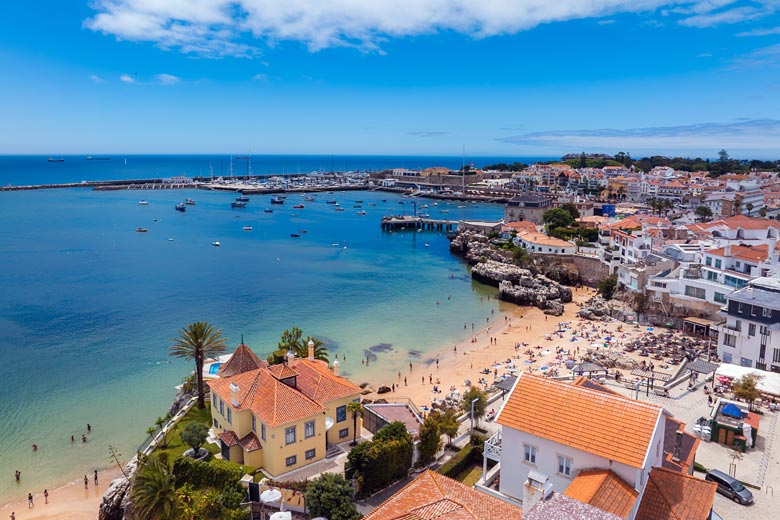Why Madeira is the perfect island escape
What makes the perfect island escape for you? Is it the feeling of wilderness and adventure? The chance to swim and experience the sea? Perhaps it's the history, culture or the cuisine.
If you're nodding yes to any of the above then it's time you considered Madeira. A volcanic archipelago in the Atlantic Ocean, it's warm in every sense of the word and allows you to do as much or as little as you like all year-round.

There's no denying that Madeira has a slight image problem; that of the blue-rinse, cruise-passengers, Flanders-&-Swann generation, variety.
While it certainly attracts mature holidaymakers who come for the mild winters and traditional activities (think Funchal's Botanical Gardens, cable car and toboggan ride), the island(s) offer so much more for all ages.
Getting to Madeira: it's never been easier or more affordable to get to Madeira thanks to Ryanair, which recently launched direct flights from Manchester (3 hours 55 mins) and London Stansted (3 hours 45 mins) for summer 2022.
Introducing Madeira
Madeira is an autonomous region of Portugal some 700 km (435 miles) off the northwest coast of Africa. It consists of eight islands, only two of which are inhabited, the confusingly-named Madeira Island and Porto Santo.
Unlike many places that were 'settled' during the Age of Discovery, when the Portuguese navigators first landed on Madeira after being blown off course in 1419, there were no indigenous inhabitants. Madeira was essentially a blank volcanic canvas.
Fast forward some 600 years and, today, Madeira is an island oasis with a temperate climate, rocky landscape and abundance of activities from heritage routes to walking trails.
Year-round whale & dolphin watching
Given its location, it's no great surprise that there are excellent opportunities for cetacean-watching. What you're likely to see depends on when you visit but pilot and sperm whales and bottlenose dolphins are usually spied all year-round.

Other species of whales including humpback, minke, fin and sei, and dolphins like common, striped and Atlantic-spotted, can be seen at different times of the year.
The best time is typically between April and October, with May to June and September to October the most likely periods.
There's a variety of trip types to choose from such as catamaran cruises including food, drinks and the chance to swim, high-speed sea safari excursions and private tours.
Gravity-defying skywalk
Prepare to be spellbound by the scale of this volcanic island on a visit to Cabo Girão Skywalk. This free-to-enter attraction consists of a glass platform jutting out from some of the highest sea cliffs in Europe.
At 580 m (1,902 ft) above sea level, the skywalk gives you a fantastic view of the southern coastline including Funchal and the neighbouring town of Câmara de Lobos.
Cabo Girão is a popular place for hikers while a steep cable car, originally installed for the farmers who till the inaccessible land below, transports you to and from a secluded beach.
Natural swimming pools
As a volcanic island, Madeira is not the place to find long golden beaches. It's more about black sand stretches, pebbly bays and natural pools or lidos.
One of the island's most popular destinations for swimmers is the pretty town of Porto Moniz in the northwest of the island. Sandwiched between the rock and the sea, this rural community is known for its complex of natural pools.

Formed by lava flowing into the Atlantic Ocean millennia ago, these saltwater pools, refreshed by the tide, promise crystal-clear swimming with splendid sea views.
Porto Moniz Natural Pools are the most popular and well-managed. Access for a few euros to enjoy the facilities including a bar, changing area and kids' pool. Other nearby natural pools, including Cachalote and Seixal, are free to enter.
Sweet treats
When the Portuguese settled Madeira in 1400s, the rocky terrain, as much as 23% of which remains enveloped in UNESCO-protected laurel forests, initially made farming tricky. But terraces were slowly carved into the fertile land and wheat became the main crop.
This proved impractical long term and, in a bid to fill the hole left by dwindling wheat exports, Prince Henry the Navigator, who was instrumental in the expansion of the Portuguese Empire, introduced sugarcane, or "White Gold", to Madeira in the 15th century.

Thanks to the island's subtropical climate, location along the trade routes and, in no small part, access to slave labour, sugarcane production flourished. Madeira was, for a time, the world's leading producer and the crop central to the island's economy. It transformed Funchal into a major trading port and stopping point.
By the 17th century, however, the centre of the sugar industry had shifted south towards larger colonies such as Brazil and Madeira's sugarcane cultivation declined.
Top tip: try the suggested sugarcane and rum route.
Sugarcane is still grown on Madeira and, if you're there in April or May, you'll see the ripe purple canes being harvested, bundled together and left to dry on the terraces.
Today, there are four active sugarcane mills on Madeira, and a visit to Calheta's Sugar Cane Mill, a living museum that charts the story of Madeira's sugary past, is essential.
Alternatively, head to Engenhos do Norte, or North Mill Distillery, to learn all about rum production before sampling the goods.
Where to stay: Funchal is the heart of Madeira and a good base from which to set about exploring. Check out VidaMar Resort Madeira*, for its great location and competitively-priced stays in modern, spacious rooms. Fizz at the breakfast buffet included.
A land of plenty
The boom and eventual bust of the sugarcane industry paved the way for other crops. Namely, banana plantations in the south and vineyards in the north.
You can't miss the terraces of billowing banana plants that blanket the southern slopes of the island, where conditions are generally warmer and drier and the altitude lower.

Around 80% of Madeira's bananas, which are harvested all year round, are exported to mainland Portugal but don't worry, that 20% leaves plenty for you to taste.
To really understand the importance of bananas to Madeira as well as learn about the various species and how they, along with other tropical fruits such as papaya, mangoes and avocados, are grown and harvested, be sure to visit a plantation.
A guided tour will furnish you with everything you need to know plus tastings of exotic fruit grown on-site.
Wine heritage
If you gift yourself one thing, let it be a full-day wine tour to truly get under the (grape)skin of the island's most iconic product, fortified Madeira wine. You'll also learn all about its burgeoning still, or table, wine production, too.
The tour begins at historic Blandy's Wine Lodge, which is crucial for cementing your understanding of Madeira wine. A former monastery-turned-distillery in Funchal, Blandy's is the only producer that remains independent and in the family's hands more than 200 years after production began in 1811.
Book your tour: experts such as Wine Tours Madeira run a fabulous one-day tour. You'll soak up lots of information, be well-fed with a traditional lunch and well-watered with plenty of tastings. Not to be missed.
Your visit to Blandy's includes an expert guide who'll walk you through the evolution of the company and the wine, including varieties of grape, such as Malvasia, and the Blandy's process. This is topped off with a guided tasting.
If you're tempted to buy from Blandy's but worried about your hand luggage allowance, use your entry ticket to not only get 10% off in the shop but pay for your wine in advance and collect it on departure from the exclusive Blandy's outlet after security at Funchal Airport.
Top tip: another way to dive into Madeira's wine scene is by visiting during the annual Madeira Wine Festival.
This takes place during the harvest in late August and early September with tastings, workshops and performances celebrating the island's wine heritage.
Levada walks
For something exclusively Madeiran, lace up sturdy hiking boots and tackle some of the island's Levada trails. The Levadas, which roughly means 'to take', carry water from the north of the island to the south through an elaborate network of man-made irrigation channels.

These innovative waterways, which date in part from the 15th century and, at their peak, totalled around 2,500 km, were originally created to sustain agriculture.
Today, only (!) around 1,000 km remain in use and the water now contributes to Madeira's hydroelectric power as well as the farming industry. The access paths make superb walking routes that snake alongside the waterways.
The ultimate way of squeezing the most out of your walk is with a knowledgeable local guide who can drip feed information about the history and wildlife as you go.
The next best option is to check the status of each walk, get hold of a good map and acquaint yourself with the symbols seen along the waymarked trails to ensure you don't get lost! Best not rely on your phone though, as signal comes and goes along these remote trails.
Laid-back Porto Santo
The neighbouring, comparatively low-lying island of Porto Santo sits in stark contrast to the rugged shores and black sand beaches of Madeira Island.
Loved by locals and visitors, this petite island, just 11 km long and 6 km wide, is a peaceful retreat for those after seriously soft sandy beaches and gently lapping waters without an abundance of facilities or fuss.

Its nickname, Golden Island, is no misnomer, as is evidenced along the near 9-km-stretch of Praia Porto Santo. The star of the show, this glorious sandy beach winds past numerous villages and feels a world away from Madeira Island, which is, in fact, just over 60 km (40 miles) to the southwest.
You can fly in around 25 minutes but it's more fun (and affordable) to take the two-and-a-half-hour Porto Santo Line ferry from Funchal. This operates daily, except on Tuesdays between October and June. It is popular, so be sure to book in advance.
Weather in Madeira
| Jan | Feb | Mar | Apr | May | Jun | Jul | Aug | Sep | Oct | Nov | Dec | |
|---|---|---|---|---|---|---|---|---|---|---|---|---|
| Maximum daytime temperature °F |  59 59 |
 59 59 |
 61 61 |
 61 61 |
 64 64 |
 68 68 |
 72 72 |
 73 73 |
 73 73 |
 70 70 |
 64 64 |
 61 61 |
| Hours of sunshine (daily) | ||||||||||||
| Days with some rainfall |  12 12 |
 11 11 |
 10 10 |
 9 9 |
 6 6 |
 5 5 |
 2 2 |
 3 3 |
 6 6 |
 10 10 |
 11 11 |
 12 12 |
| Sea temperature °F |  64 64 |
 64 64 |
 64 64 |
 64 64 |
 66 66 |
 70 70 |
 72 72 |
 73 73 |
 75 75 |
 73 73 |
 70 70 |
 68 68 |
While the average subtropical conditions in Madeira make it appealing all year round, the weather is changeable not to mention localised thanks largely to its mountainous core.
It's best to pack a range of clothing including layers for evenings and waterproofs, especially if you're venturing to the north of the island, which typically sees a bit more passing rainfall.
Ready to experience Madeira? Check out the latest deals from Ryanair, which offers great value direct flights from Manchester and London Stansted until October 2022.
Please note: Weather2Travel.com experienced Madeira in April 2022 with assistance from Visit Madeira. All views expressed are those of the writer.
More about Madeira
- Overview
- Best time to visit
- Weather by month
- 5-day weather forecast
- Destinations
- Travel advice
- Deals & discounts
Madeira by month
Jan Feb Mar Apr May Jun Jul Aug Sep Oct Nov Dec
Explore holidays in the sun for less
- Beach holidays
- Family holidays
- City breaks
- Summer holidays
- Winter sun holidays
- Holiday offers
- Top travel brands
- Airlines & flights
- Discount hotels
- Airport parking deals
- TUI
- Jet2holidays
- easyJet holidays
- Love Holidays
- January sales
Airport parking
- Manchester Airport
- Stansted Airport
- Bristol Airport
- Luton Airport
- Birmingham Airport
- Edinburgh Airport
- Gatwick Airport
- Glasgow Airport
- Newcastle Airport
Airport lounges
- Manchester Airport
- Birmingham Airport
- Bristol Airport
- Edinburgh Airport
- Glasgow Airport
- Heathrow Airport
- Newcastle Airport
- Stansted Airport
- Gatwick Airport
Be inspired
Get your weekly fix of holiday inspiration from some of the world's best travel writers plus save on your next trip with the latest exclusive offers
We promise not to share your details















